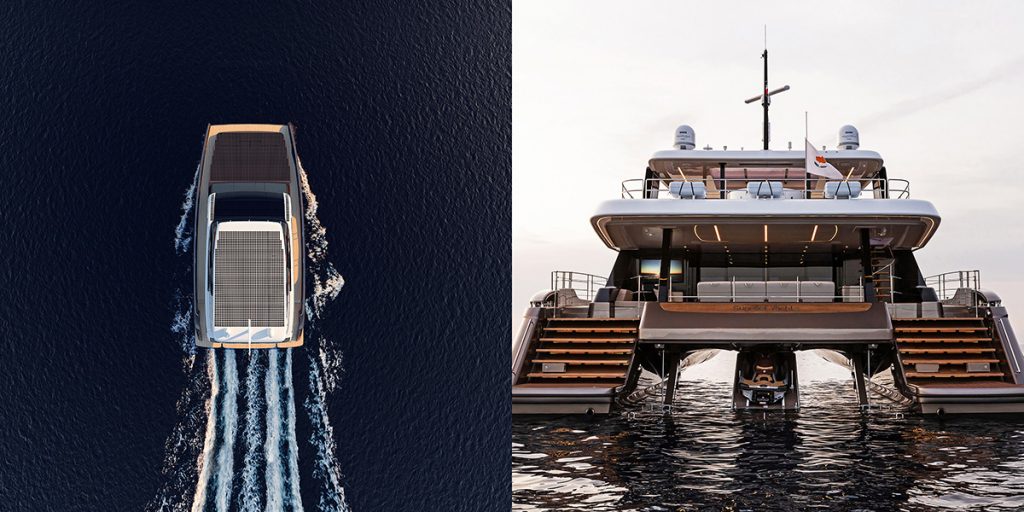You can’t escape the global sustainability push. “Doing your bit” is no longer a case of chucking the odd bottle into a recycling bin and reusing a crumpled plastic shopping bag from under the sink. It’s become a lifestyle. A bit of a necessary one.
And as with any new lifestyle, there are varying degrees to which we integrate it into our old one. Living a sustainable life to one person may be a move towards eating more organic food and cutting down on meat products. To another, it could be swapping a gas-guzzling SUV for a Tesla. And for a lucky few, it could mean sailing into the sunset on one of Sunreef Yacht’s eco-catamarans.
It’s no secret that the yachting industry isn’t exactly eco-friendly. That rainbow sheen on the water’s surface in any port will tell you that. Then there’s the cross-Atlantic voyages, the importation of exotic woods and the sending out of helicopters to retrieve a specific type of lobster – badges of honour within the yachting community – that we have to contend with.
Yet there has been a noticeable shift as of late. These elements of a “conspicuous consumption of wealth” that has so defined this industry have turned a tide (pardon the pun). And Sunreef are riding that wave.
Sustainability is now luxurious in itself. In fact, it’s the new badge of honour.

Sunreef Yachts Eco are at the helm (sorry) of this responsible yachting movement with their new range of sail and power – electric – catamarans. Inside and out, these eco catamarans herald energy saving, with no loss of luxury.
First up: Solar Skin. Sounding like the sea-hardened hands of an old skipper, Sunreef’s Solar Skin are solar panels that have been cleverly and subtly integrated into the yacht’s framework. In fact, they can be mounted pretty much anywhere including on the hull, superstructure and mast. They are the industry’s lightest panels. Which, if you’re in the business, know is a big deal.
These panels then team up with ultra-light batteries – custom-engineered marine battery packs. With a density below 5.2kg per kWh, they can be recharged in various voltages. Technical speak aside, this means that the batteries can run things like the air-con through the night, using up to 70% less energy than other yachting systems. And thank your lucky deodorant as they can even provide for top humidity control even in tropical climates.

But when you think of luxury yachting you don’t think solar panels and marine battery packs. Luxury is all in the look and feel of something. You’re not exactly going to make your batteries the first port of call when showing off to your friends.
This is where Sunreef has also got it right in their sustainable yacht design; sustainable décor. Having to think about a product’s origin may feel limiting. But a careful consideration of materials – and their carbon footprint – can actually open up a world of possibilities. Even if that means looking closer to home.
Sunreef have been careful to take the old-school durability x quality x aesthetics approach, ensuring that the interiors of their eco-catamarans are timeless and won’t need to be replaced after a few years. They take the entire lifecycle of any product used within their catamaran into consideration, and this focus on sustainability has paid off; the interiors are stunning.

Natural materials like linen, wool and bamboo are in abundance, as well as other recycled materials – like ecological suede. Unless you have a microscope to hand, telling the difference between recycled materials and the real thing is impossible. And this really is the driving force behind ethical luxury.
But it’s not only Sunreef whose focus has shifted; ours have too. There has been a surge of new enthusiasts entering the industry being more aware of the impact yachting has upon the planet, and they are willing to compromise.
This growing consciousness of eco-materials has presented yacht designers with a new challenge, and new styles to contend with. Yet as demand grows, so does supply and development. This can only be a good thing.
Sunreef has got their approach to sustainable yachting right. Ultimately, we all want to be on the water because we love it. And by making the move towards a green yachting lifestyle, we can enjoy it at the same time as helping to eliminate marine waste.

Francis Lapp – Founder & Ceo
“In the early 90s I started racing on small catamarans. I owned a Hobie 14 & 16. I then bought a couple of power catamarans for a charter fleet I set up in Madagascar. I gradually became disappointed with their level of finish and overall quality. This wasn’t my vision of luxury. And this is how my idea became clear: I needed to redefine the word “catamaran” and give it a luxury edge.”
“The launch of the first Sunreef catamaran was the first major step. I knew I had quite a unique product. At the time, luxury catamarans were non-existent. On top of that, my boat had a flybridge – the world’s first on a catamaran.”
“Our yachts are a relevant response to what people are looking for at sea. Our creative approach to yacht design is something that has built our reputation. Perseverance is what keeps the company running. I rarely ever give up.”
“Today we are building superyachts. It’s both a challenge and a reward. I feel pride because I see it as a recognition of our achievements and evidence of our expertise in multihulls. We are currently building a 49 meter motoryacht”
“The Sunreef Yachts Eco catamarans are part of our brand philosophy and a message at the same time. The idea behind this new range is a 360-degree approach to sustainability. All of this is an effort in order to have a harmony of luxury and sustainability. Those two worlds belong together.”

